Respiration in Organisms Class 7 Notes Science Chapter 6
| Table of contents |

|
| Why do we Respire? |

|
| Breathing |

|
| How do we Breathe? |

|
| What do we Breathe out? |

|
| Breathing in Other Animals |

|
| Breathing Under Water |

|
| Do Plants also Respire? |

|
| Some Important Definitions |

|
Boojho was excited to meet his grandparents and ran to the bus stop. He noticed that he was breathing rapidly after running. His grandmother explained that this was because his body needed more energy. This curiosity led Boojho to wonder why running makes us breathe faster. This chapter will answer that question by exploring the process of respiration.
Why do we Respire?
We respire to obtain energy from the food we eat.
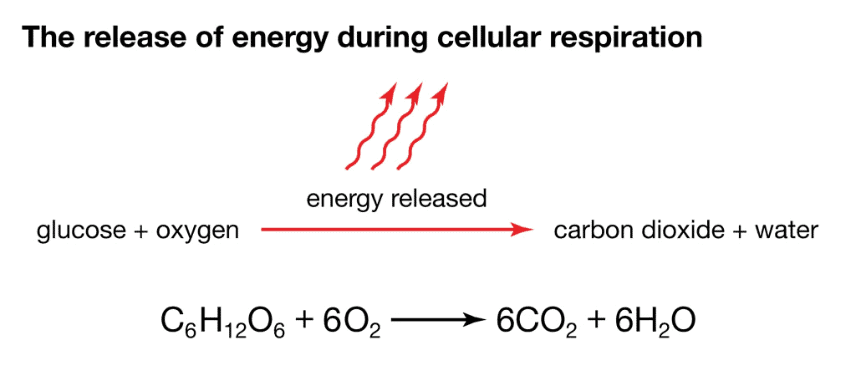 Respiration releases energy
Respiration releases energy
Here’s why respiration is essential:
Energy Production: Cells need energy to perform vital functions like growth, repair, and maintenance. Respiration helps break down food (glucose) to release this energy.
Cellular Function: Respiration occurs in every cell to provide the necessary energy for processes such as nutrition, transport, excretion, and reproduction.
Continuous Need: Energy is required all the time, whether we are active or resting. Respiration ensures that cells consistently receive the energy they need.
In summary, respiration is crucial for producing the energy necessary for sustaining life and supporting all cellular activities.
What is Respiration and Its Types
Respiration is a crucial process that allows all living organisms to extract energy from food.
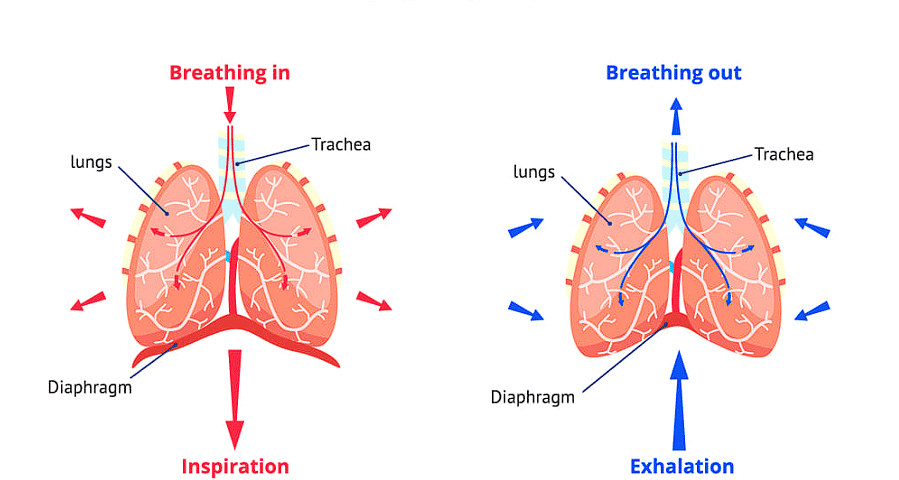 Respiration in Organisms
Respiration in Organisms
- It begins with breathing: inhaling air rich in oxygen and exhaling air that is high in carbon dioxide. This oxygen-laden air is transported throughout the body and reaches every cell.
- Inside the cells, oxygen aids in breaking down food through a process called cellular respiration, which releases the energy needed for various functions.
- This essential process, occurring in the cells of all living beings, involves the breakdown of food to obtain energy.
Types of Respiration
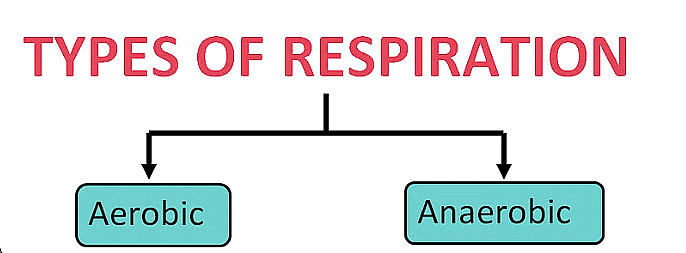
1. Aerobic Respiration
Aerobic respiration is the process of breaking down nutrients (usually glucose) in the presence of oxygen to produce energy (ATP), carbon dioxide, and water.
C₆H₁₂O₆ (glucose) + 6O₂ (oxygen) → 6CO₂ (carbon dioxide) + 6H₂O (water) + Energy (ATP)
Examples of Aerobic Respiration: Humans
2. Anaerobic Respiration
Anaerobic respiration is the process of breaking down nutrients (such as glucose) without the use of oxygen. It is a less efficient process compared to aerobic respiration.
C₆H₁₂O₆ (glucose) → 2C₃H₆O₃ (lactic acid) + Energy (ATP)
C₆H₁₂O₆ → 2C₂H₅OH + 2CO₂ + Energy
Examples of Anaerobic Respiration: Yeast
Note: Yeast, being unicellular organisms, undergo anaerobic respiration, producing alcohol in the process. This characteristic makes them valuable in the production of wine and beer.
Differences Between Aerobic And Anaerobic Respiration
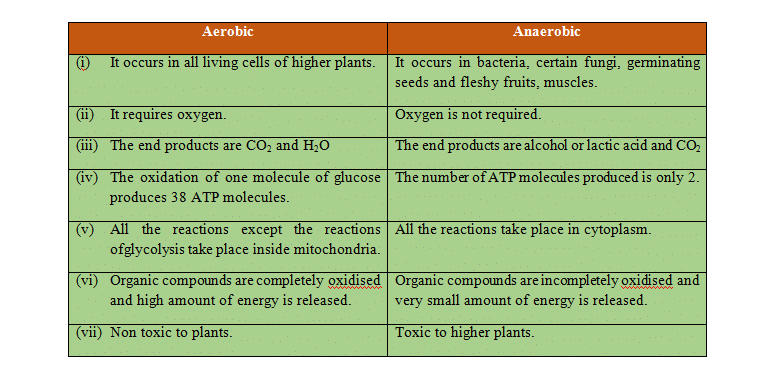
Have you ever wondered about the cause of muscle cramps post-intense exercise?
These cramps arise from anaerobic respiration in muscle cells, leading to the production of lactic acid through partial glucose breakdown. The accumulation of lactic acid is responsible for the cramps.
 |
Test: Respiration in Organisms
|
Start Test |
Breathing
Breathing involves the intake of oxygen-rich air and the release of carbon dioxide-rich air through respiratory organs. Inhalation refers to the intake of oxygen, while exhalation is the expulsion of carbon dioxide.
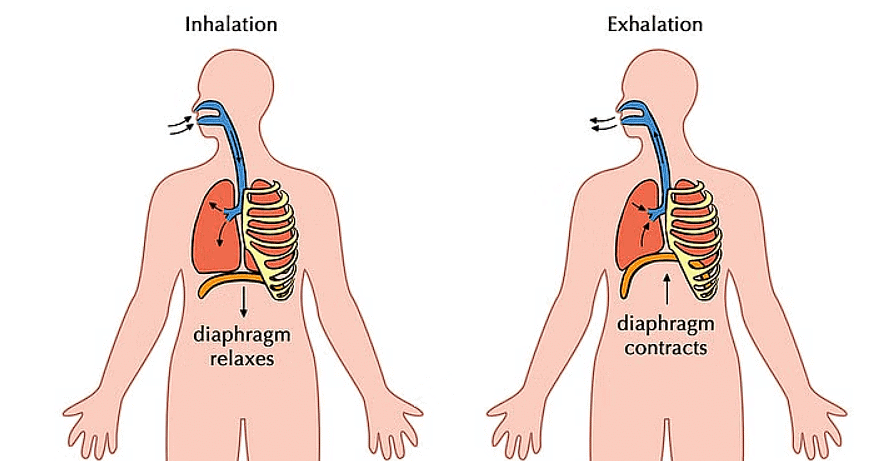 Inhalation and Exhalation
Inhalation and Exhalation
- Breathing Rate: This continuous process occurs consistently throughout an organism's life. The frequency of breaths per minute is referred to as the breathing rate.
- Inhalation and exhalation occur in a repeating pattern during breathing, and each cycle, consisting of one inhalation followed by one exhalation, is considered a breath.
How do we Breathe?
The respiratory system plays a crucial role in breathing, and each part (nostrils, nasal cavity, windpipe, lungs, ribs, and diaphragm) has a specific function in the process.
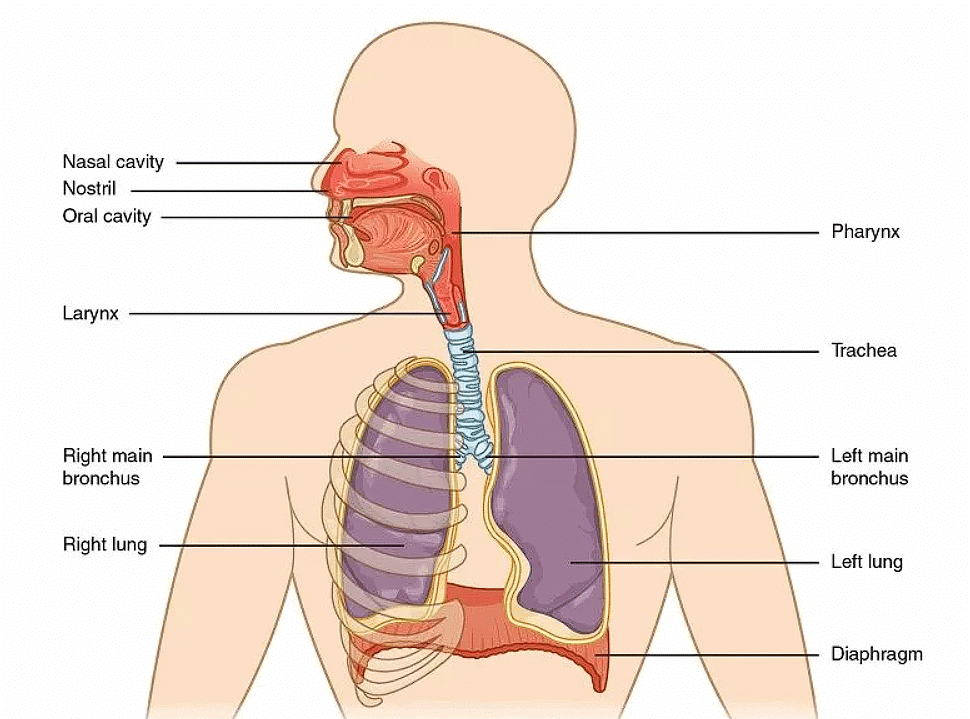 Parts of Human Respiratory System
Parts of Human Respiratory System
(a) Nostrils and Nasal Cavity
Function: When we inhale, air enters the body through the nostrils. The nasal cavity serves several functions, such as filtering, humidifying, and warming the incoming air. It also contains small hair-like structures called cilia, which help trap dust and particles.
(b) Windpipe (Trachea)
Function: The trachea is a tube that connects the nasal cavity to the lungs. It allows the passage of air between these two regions.
(c) Lungs
Function: Lungs are the primary organs of the respiratory system. Oxygen from the inhaled air diffuses into the blood, and carbon dioxide, a waste product, is released from the blood into the lungs to be exhaled. The exchange of gases (oxygen and carbon dioxide) occurs in the tiny air sacs called alveoli within the lungs.
(d) Chest Cavity and Ribs
Function: The lungs are located in the chest cavity, which is surrounded by ribs. The ribs protect the delicate organs within the chest, including the lungs. Additionally, the ribs play a role in the expansion and contraction of the chest during breathing.
(e) Diaphragm
Function: The diaphragm is a large, dome-shaped muscle that separates the chest cavity from the abdominal cavity. During inhalation, the diaphragm contracts and moves downward, increasing the volume of the chest cavity. This expansion lowers the air pressure in the lungs, causing air to rush in. During exhalation, the diaphragm relaxes and moves upward, reducing the volume of the chest cavity, and air is expelled from the lungs.
Two Phases of Breathing
The breathing mechanism comprises two phases
- Inhalation
- Exhalation.
- Inhalation: Inhalation, an energy-demanding process, involves the simultaneous contraction of intercostal muscles and the diaphragm. This action moves the ribs outward and upward, expanding the thoracic cavity and increasing lung volume. The resulting decrease in air pressure within the lungs leads to the influx of air through the air passages.
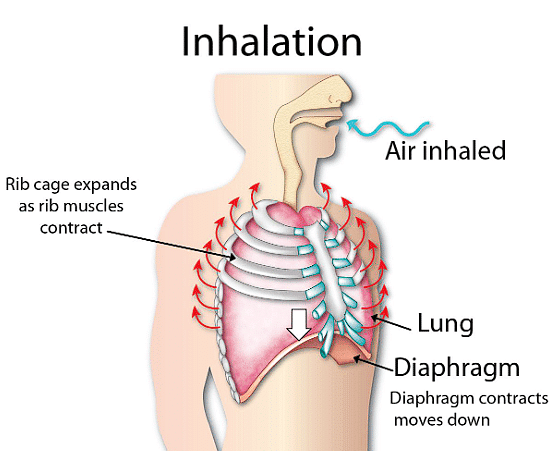 Inhalation
Inhalation - Exhalation: Exhalation is initiated by the relaxation of intercostal muscles and the diaphragm, causing the ribs to return to their original position and the diaphragm to assume a dome shape. These movements reduce the thoracic cavity's volume, bringing the lungs back to their initial volume. As a consequence, air is expelled from the lungs due to increased pressure within them, surpassing atmospheric pressure.
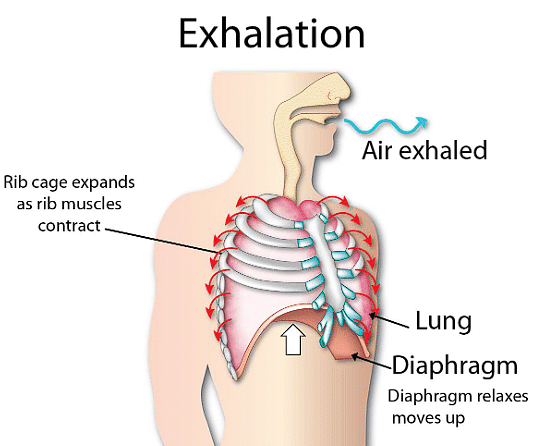 Exhalation
Exhalation
What do we Breathe out?
The respiratory system and the process of respiration, organisms, including humans, breathe out carbon dioxide (CO2). During cellular respiration, cells utilize oxygen to break down glucose and release energy.
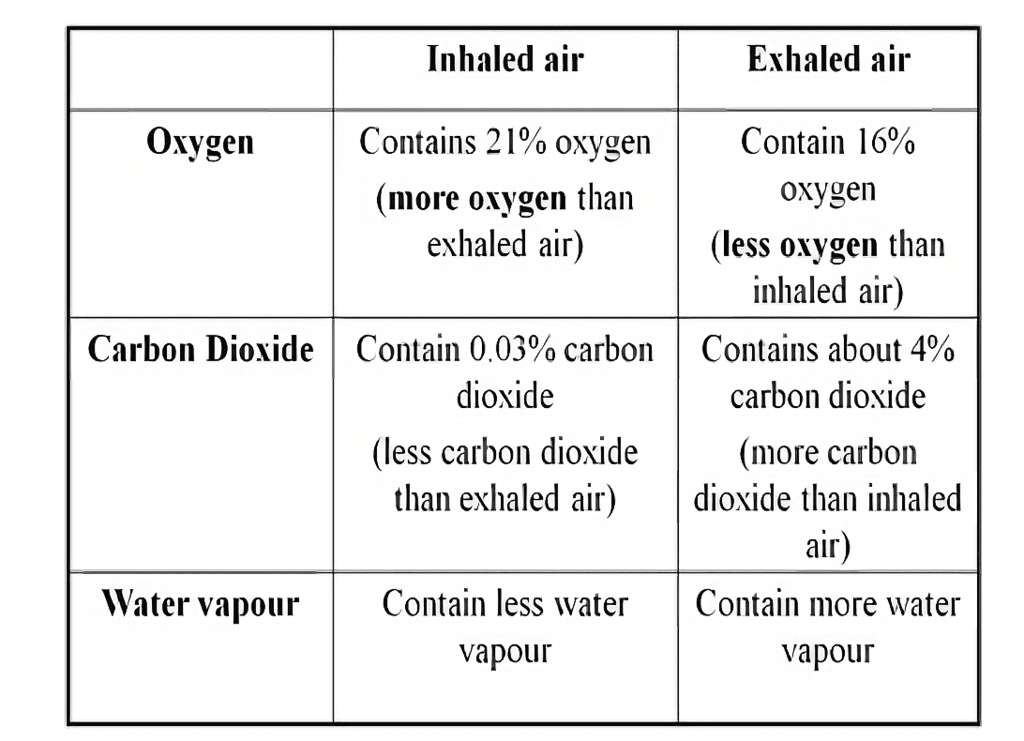 Composition of Exhaled air
Composition of Exhaled air
As a byproduct of this process, carbon dioxide is produced and transported back to the lungs, where it is expelled from the body when we exhale. Therefore, the primary gas breathed out during respiration is carbon dioxide.
Breathing in Other Animals
Many animals, including elephants, lions, cows, goats, frogs, lizards, snakes, and birds, have lungs in their chest cavities similar to humans. However, other organisms have different respiratory systems.
- Cockroach: Cockroach has small openings called spiracles on the sides of its body. Insects, including cockroaches, use a network of air tubes known as tracheae for gas exchange. Oxygen-rich air enters through spiracles into the tracheal tubes, diffuses into the body tissues, and reaches every cell. Carbon dioxide produced in the cells exits through the tracheal tubes and is expelled through spiracles. This system of air tubes or tracheae is unique to insects and is not present in other animal groups such as snails, fish, earthworms, ants, and mosquitoes.
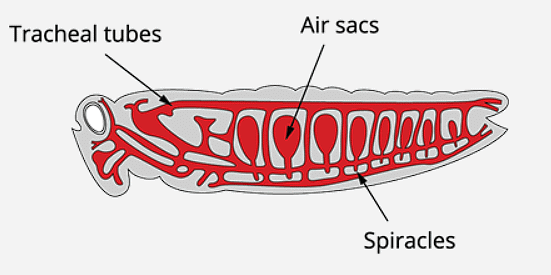 Tracheal System
Tracheal System
- Earthworm: Earthworms and frogs have unique respiratory adaptations. Earthworms breathe through their skin, which is moist and slimy, allowing gases to easily pass through. Similarly, although frogs possess lungs like humans, they can also respire through their skin, which is moist and slippery.
Breathing Under Water
Can people breathe and live underwater? No, but some animals can. For example, fish have gills that help them extract oxygen from water. Gills are like skin extensions with lots of tiny blood vessels that help them breathe by exchanging gases.
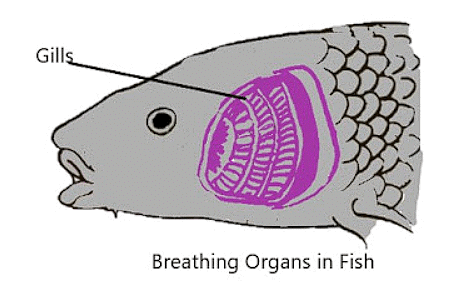
Fish can breathe underwater because they have specialized organs called gills. Gills are located on the sides of a fish's head and are responsible for extracting oxygen from the water. Here's how it works:
- Water intake: Fish take in water through their mouths by opening and closing their mouths.
- Passage over gills: As water enters the fish's mouth, it passes over the gill filaments. These gill filaments are like thin sheets with a large surface area.
- Oxygen exchange: Oxygen in the water diffuses across the thin walls of the gill filaments and into the blood vessels. At the same time, carbon dioxide, a waste product produced by the fish, diffuses out of the blood vessels and into the water.
- Water exit: The now oxygen-depleted water is expelled through openings called gill slits on the sides of the fish.
 |
Download the notes
Chapter Notes: Respiration in Organisms
|
Download as PDF |
Do Plants also Respire?
Like all living organisms, plants also respire. They take in oxygen and release carbon dioxide to survive.
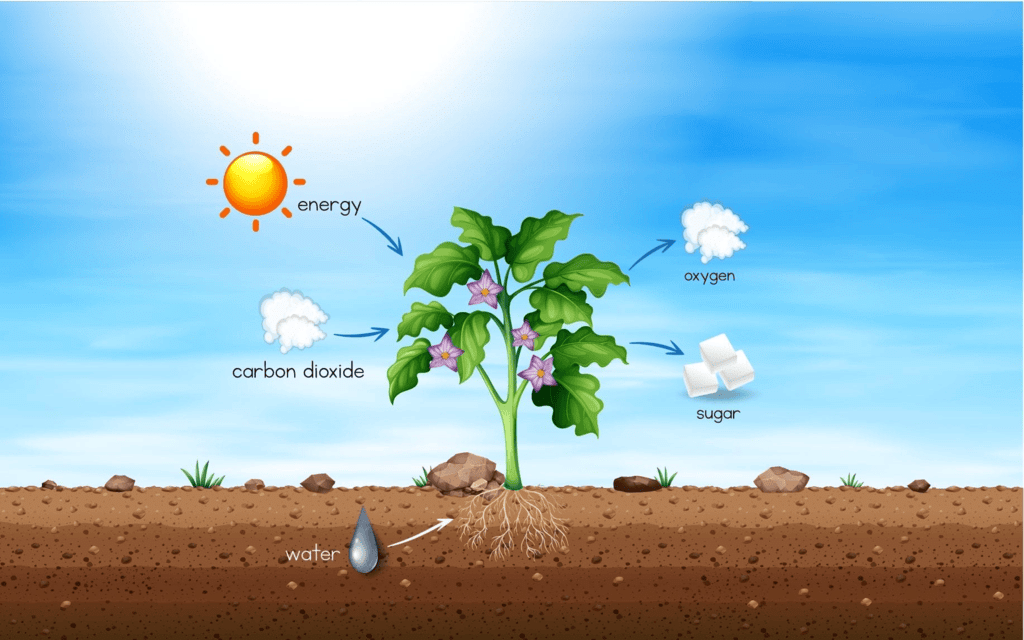 Respiration in Plants
Respiration in Plants
Cellular Respiration: Inside plant cells, oxygen is used to break down glucose into carbon dioxide and water, releasing energy in the process.
Independent Respiration: Each part of the plant, including leaves, stems, and roots, can independently take in oxygen from the air and release carbon dioxide.
Role of Stomata: Leaves have tiny openings called stomata that allow the exchange of gases—oxygen and carbon dioxide—between the plant and the atmosphere.
Root Respiration: Root cells also need oxygen to produce energy. They obtain this oxygen from the air found in the gaps between soil particles.
Some Important Definitions
Aerobic Respiration: A type of respiration that requires oxygen to break down glucose into carbon dioxide, water, and energy. It occurs in the mitochondria of cells.
Anaerobic Respiration: A type of respiration that occurs in the absence of oxygen, where glucose is partially broken down into products like lactic acid or ethanol, along with a small amount of energy.
Breathing Rate: The number of breaths a person or organism takes per minute, often used as an indicator of respiratory health or activity level.
Cellular Respiration: The process by which cells convert glucose and oxygen into energy, carbon dioxide, and water, occurring in the mitochondria.
Diaphragm: A dome-shaped muscle located beneath the lungs that plays a crucial role in breathing by contracting and relaxing to change the pressure in the chest cavity.
Exhalation: The process of breathing out air from the lungs, which removes carbon dioxide from the body.
Gills: Specialized respiratory organs in aquatic animals, such as fish, that allow them to extract oxygen from water.
Lungs: The primary respiratory organs in terrestrial animals, including humans, where oxygen is absorbed from the air and carbon dioxide is expelled.
Inhalation: The process of breathing in air into the lungs, allowing the intake of oxygen into the body.
Spiracles: Small openings on the body surface of insects and some other arthropods that allow air to enter the tracheal system for respiration.
Tracheae: A network of tiny tubes in insects that carry air directly to their cells for respiration; in vertebrates, the trachea is the windpipe that connects the larynx to the lungs.
Ribs: Curved bones that form the rib cage, which protects the lungs and other vital organs, and assist in the breathing process by moving during inhalation and exhalation.
|
112 videos|261 docs|28 tests
|
FAQs on Respiration in Organisms Class 7 Notes Science Chapter 6
| 1. What is respiration and why is it important? |  |
| 2. How do humans breathe? |  |
| 3. Do plants also respire? |  |
| 4. Can animals breathe underwater? |  |
| 5. What happens during exhalation? |  |


























